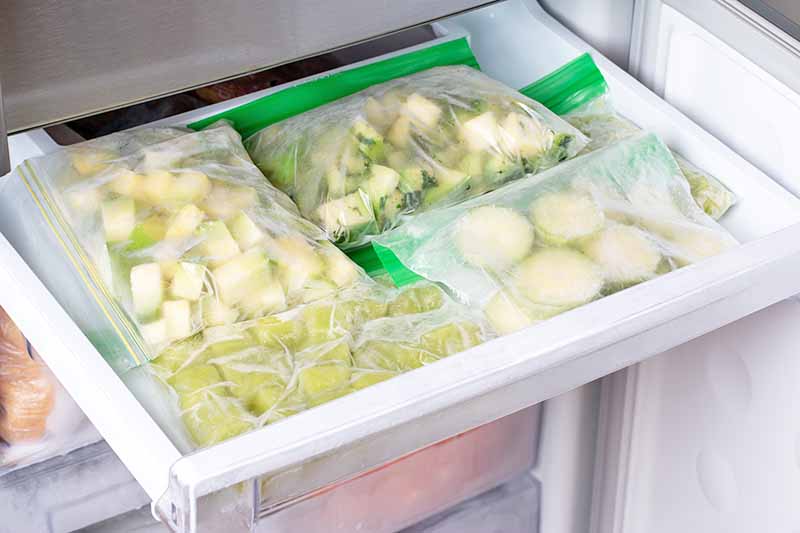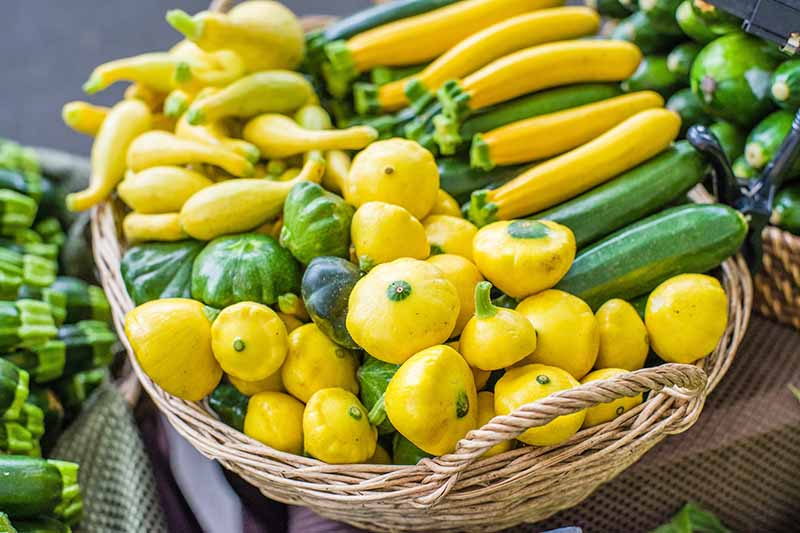From July to September, summer squash is abundant in farmers markets and widely harvested in home gardens.

One day at the local farmstand, I stood before bins overflowing with green, yellow, striped, and bicolor cylinders, rounds, tapers, and scallop-edged squashes.
I had always bought zucchini, but I wanted to branch out on this particular day and try something different. So, I selected bright yellow cylinder-shaped squash and proudly carried them home – only to learn later that they, too, were zucchini.
Has this happened to you? Then it’s time to learn more!
Read on to discover what I learned about zucchini and summer squash, and make the most of the season’s delicious selections.
Here’s what we’ll cover:
What You’ll Learn
Let’s jump right in.
What Is Summer Squash?
Summer squash, aka yellow squash, has ancient roots in Central America and Mexico. Today’s varieties fall into the following groups: cocozelle, crookneck, scallop, straightneck, and zucchini.

The color palette includes bicolor, green, orange, white, and yellow, with bumpy or smooth skin.
Let’s consider each of these.
Cocozelles are dark green with light green stripes and a cylinder shape. They have a rich nutty flavor.

Crooknecks have a bent upper portion and a bulb-shaped bottom. They have a sweeter taste, more like pumpkin and other winter varieties.

Scallops, aka pattypans, are disk-like with scalloped edges. Some call them flying saucer or UFO squash. They are sweet and mild.

Straightnecks have a club-like shape. They are mildly sweet and buttery.

Within the straightneck group you’ll find a cultivar known as ‘Zephyr,’ a green and yellow hybrid. These are mildly sweet with grassy undertones.

Summer squash is harvested in as few as 50 days, when it is immature and has thin, edible skins, tender pale yellow to pale green flesh, and soft seeds. You can learn more about growing your own on our sister site, Gardener’s Path.
There are also winter varieties, like acorn, butternut, Hubbard, peanut, and pumpkin, that may take up to 120 days to mature. These have firm, inedible skin, yellow to orange flesh, and hard seeds that are palatable when toasted or roasted. They have a more pronounced, sweet, pumpkin-like flavor.
And while we serve squash as a vegetable, biologically, it is a fruit. Specifically, it is a berry called a “pepo,” hence the botanical name, Cucurbita pepo subsp. pepo.
A Zucchini Is Born
Zucchini is a unique type of summer squash. It dates to Italy in the 1500s. At that time, the fruits had not only arrived in Europe, they were already under cultivation and had become a household staple in Milan.

One day, believed to be in 1850, it seems Mother Nature worked her magic, and a mutation appeared in a squash patch. This time, as the first pollinated blossom receded, a cylindrical green vegetable sprouted instead of a yellow one.
Apparently, the name itself was already in use and referred to a bottle gourd that was also green and consumed when young and tender. Soon the new green vegetable was being called a zucchini, and the gourd waned in popularity.

Today, in addition to traditional green, modern cultivars come in other colors, like the bright yellow ones I bought, as well as light green and orange varieties.

While similar in flavor to other types of summer squash, they has earthy undertones that impart a subtle savory quality.
A Note on Cucurbitacins
While rarely found in commercially grown zucchini, cucurbitacins may be present. These bitter-tasting biochemical compounds deter herbivores from feasting on wild versions of zucchini.
Environmental stress and cross-pollination with a wild plant may cause an overabundance of cucurbitacins in cultivated plants.
Always err on the side of caution and discard bitter fruits to avoid gastrointestinal upset.
In essence, this is similar overall to the common refrain to explain that a square is a rectangle, but a rectangle is not a square. Zucchini are in fact a particular variety of summer squash.
Shopping and Storing
When making your purchases, choose fruits that are firm under gentle pressure. There should be no scratches, nicks, soft spots, or discoloration.

Store fruits in the vegetable crisper drawer of the fridge and plan to use them within the week. Wash them just before use.
You can freeze any extras.
Coin or cube the fruits and blanch them in boiling water for three to five minutes, cool them completely, and place the cooled cubes in zippered plastic bags. Gently press out excess air and seal. Use within three months.
In addition, you can puree the fruits and freeze them to make your own baby food or soup ingredients.
Cook and puree the fruits, cool the puree, and pour it into ice cube tray sections and freeze. Once they are completely frozen, release them from the tray.
Place the frozen cubes in a single layer in a zippered plastic bag. Squeeze out excess air and seal. Use within three months.
In the Kitchen
Per the USDA, the nutritional content is the same for zucchini and other types of summer squash.

A 100-gram raw, skin-on portion of any type, in addition to other vitamins and minerals, contains about:
- 17 kcals (calories)
- 94.8 grams of water
- 1.21 grams of protein
- 3.11 grams of carbohydrates
- 1 gram of dietary fiber
- 2.5 grams of total sugar
- 261 milligrams of potassium
- 200 micrograms of vitamin A
- 17.9 milligrams of vitamin C
All types may be used interchangeably in prepared foods, like breads, side dishes, and soups. You can bake, broil, fry, grill, roast, saute, or steam them.
However, some lend themselves to specific recipes better than others,
For example, if a recipe calls for stuffing the fruit, scallop types and other round options are suited to creating a fillable well with a top “cap.”
Straightnecks and other long, skinny varieties make attractive and tasty scooped-out, open-top “boats” topped with melted cheese or toasted breadcrumbs.

And if you run out of cucumber for your salad, raw summer squash can serve as a substitute in a pinch.

It may not be as flavorful, and the texture may be more fibrous, but like overripe bananas, it’s still suitable for making bread. Try this recipe for zucchini bread, or a decadent chocolate version.

Sample and Savor
I’ve been a zucchini devotee since childhood. We purchased it weekly when it was in season, never so much as glancing at the pattypans or crooknecks.

It’s common to follow our family’s food traditions without realizing we’re failing to give new foods a chance.
I hope I’ve inspired you to broaden your squash horizons. While the flavor differences may be subtle, the varied shapes and colors bring new excitement to the table.
Are you ready to try robust recipes for late-season fare, like hot chili marmalade, sweet and tangy summer squash quinoa, summer squash soup, and crispy veggie fries?
Let us know what you’re cooking! And be sure to check out our article on 11 tasty ideas for a bumper summer zucchini crop.
If you found this guide informative and would like to learn about other fruits we eat as vegetables, we recommend the following next:
- Fresh Cucumber: Lots of Possibilities, Low in Calories
- Pumpkins and their Different Uses
- Tantalizing Tomatoes: Rich, Juicy Flavor & Outstanding Health Benefits
Photos by Meghan Yager, Fanny Slater, and Kelli McGrane, © Ask the Experts, LLC. ALL RIGHTS RESERVED. See our TOS for more details. Uncredited photos: Shutterstock.
About Nan Schiller
Nan Schiller is a writer from southeastern Pennsylvania. When she’s not in the garden, she’s in the kitchen preparing imaginative gluten- and dairy-free meals. With a background in business, writing, editing, and photography, Nan writes humorous and informative articles on gardening, food, parenting, and real estate topics. Having celiac disease has only served to inspire her to continue to explore creative ways to provide her family with nutritious locally-sourced food.




